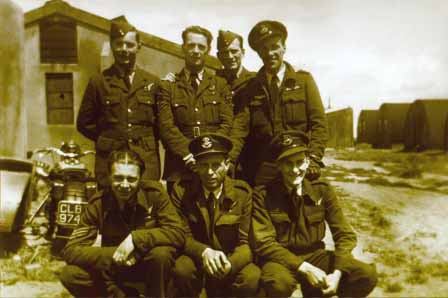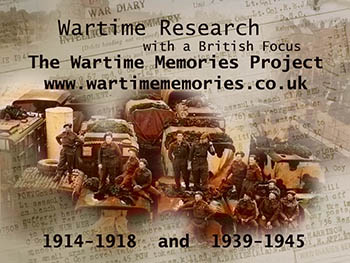P/O George "Geordie " Wade. 24 Operation Training Unit
I Flew With The Canadians
I was called up into the RAF from Durham University Air Squadron on 9th May 1942 as an aircrew trainee aged 19½ years of age, and spent three weeks of induction at ACRC London living in Avenue Close, St John’s Wood. There followed three weeks in the Metropole Hotel in Brighton before posting to No 9 EFTS, Ansty, Warwickshire for the aircrew grading course. This involved 12 hours dual instruction in DH82A “Tiger Moth” aircraft in which we did “the whole business” of flying, up to spins and recovery from spin. I absolutely loved it but I failed to go solo.
From there we went to Heaton Park, Manchester where we lived in small ridge tents awaiting our new gradings. I was to become a Bomb Aimer (officially Air Bomber).
After seven weeks, many of us were sent to Marine Court, St Leonards on Sea (9½ hours by train) to wait for posting to training units. I was on the 12th floor and lifts were not operating! I became very fit going up and down the stairs several times a day for four weeks.
The building was attacked twice by cross-channel Me109 and FW190 fighter bombers and on the second occasion it was slightly damaged, so we went back to Heaton Park via Harrogate (9 hours). One week later we travelled to Gourock (10 hours by train) to board RMS Queen Mary. There were 18 to a cabin and only 2 meals a day. These were meals like pre-war food because these troopships stocked up in the USA. We had actual white bread (unlike the National Loaf at home) and sausages with meat in them!
On board we could buy plenty of Coke and chocolate and cigarettes were 2/6d for 200. After landing at Boston, Mass, we took the train up to Moncton, NB through the brilliant autumn colours of New England. 4 days later it was a CNR train journey across Canada via Lake Superior and the prairies to No 5 Bombing and Gunnery School at Dafoe, Sask. On completing that course we were posted to No 1 Central Navigation School at Rivers, Manitoba on New Year’s Eve 1942. There we did cross-country flights (map reading and bombing for me) in temperatures at night as low as -40ºC. The engines of the Avro Ansons had to have their oil diluted with petrol to facilitate starting in those freezing conditions.
There were individual ice crystals falling from the sky and the Northern Lights were spectacular. Completion of that course saw us on Wings parade and promoted to Sergeant. Then it was CPR train back to Moncton with a stopover at Montreal. At Moncton I was promoted to Pilot Officer and given $180 for kitting out (at T. Eaton Co). Soon afterwards it was train down to New York to board RMS Queen Elizabeth for the trip back to the Clyde. This time the cabin accommodation was the same as on the trip out but being an officer, I had meals in the first class saloon served by stewards. Both trips across the Atlantic were by Southern latitudes to avoid the U-boat packs in the North.
Back in the UK there was more bombing, gunnery, astro-navigation, map reading and signals at No 1 (O) AFU at Wigtown near Newton Stewart in the South West of Scotland. Then more of the same at No 24 OTU at Honeybourne, Gloucestershire where crews were formed.
I crewed up with Sgt RC Reinelt (Pilot), Sgt “Johnny” ARW Hardes (Nav), Sgt DH Williams (W/Op A/G) and RCAF Sgt G Dykes (A/G). After that it was a move to 6 Group RCAF, starting at 1659 Heavy Conversion Unit at Topcliffe where we trained on old MKI Halifaxes and on 16th September 1943, I celebrated my 21st birthday. We went on to RCAF Squadron 429 at Leeming having picked up a F/Eng Sgt JE Peppercorn and a mid-upper gunner RCAF Sgt “Curly” Shields making a crew of seven.

Crew of Q Queenie at Skipton on Swale, 433 Squadron April 1944
Back Row Left to Right:
Sgt DE Carruthers, M-U Gunner RCAF.
Sgt DH Williams, W/Op A/G RAF.
Sgt ARW Hardes, Nav RAF.
P/O RC Reinelt, pilot RAF.
Front Row Left to Rig:
Sgt JE Peppercorn, FL Eng RAF.
P/O G Dykes, Rear Gunner RCAF.
F/O GM Wade, Bomb Aimer RAF.
At 429 Squadron (Motto : FORTUNAE NIHIL – nothing to chance) led by W/Cdr Patterson DFC (known to us as “2650 + 4” because of his insistence on such revs and boost for economical cruising), we flew Halifax MK II’s. Although we were based at Leeming we actually flew from Skipton-on-Swale.
When we, as a crew, had done four ops we were posted to Skipton as part of the nucleus of five crews to start 433 Squadron (Motto : QUI S’Y FROTTE S’Y PIQUE” = whoever rubs himself there will be pricked there) – the Porcupine Squadron. One crew piloted by RCAF P/O Chris Nielsen (nicknamed “the mad Dane”) had done 15 ops and so were very experienced.
At Skipton we flew Halifax Mk III’s under the leadership of W/C Clive Sinton DFS, a superb CO, and the aircraft were totally trustworthy and good performers. In a tragic accident in late December 1943 an aircraft piloted by F/O PR Humphries was taking off at Skipton and crashed on to our aircraft which was parked at dispersal. The five crew members and two ground crew members were all killed and both planes were destroyed in the resulting blaze. Since I was the only officer in our crew at the time, I was appointed officer in charge of the escort party at the funeral of these seven men. The funeral took place in Harrogate on Christmas Eve which was a very frosty day. It was a truly miserable occasion. I cannot imagine what was put in the coffins since both planes were reduced to ashes. Normally each carried 1800 gallons of petrol plus ammunition for the guns, and some flares.
I trained on H2S and Gee, while the Squadron was expanding, and my task apart from bombing was to take and log fixes every two minutes when possible, sitting alongside the navigator. I assisted the pilot with engine controls on take off and landing and took over from him occasionally especially on training flights and returns from operations. I was also expected to be emergency pilot as well as deputising for other crew members, should the need arise.
At an early stage at 433 Squadron “Curly” Shields went back to Canada and we were joined by RCAF Sgt Doug Carruthers as Mid-Upper Gunner. Three of the five crews who formed the nucleus of 433 Squadron were soon lost on ops leaving Chris Nielsen’s crew and ours. Sadly Chris and his crew were shot down just short of the target on their 27th op. and at least one of the crew, F/Eng P/O Christopher Panton, was killed. This was the disastrous raid on Nuremberg (30th/31st March 1944) when 95 aircraft were lost. It was nearly 96 because we were attacked by a Me210 just after leaving the target. We lost an engine and two fuel tanks when we were hit by 3 cannon shells which resulted in a fire in the wing. We were able to make the trip back to Englnd landing at Manston in Kent. This was our 15th operation.
The skipper was commissioned and received an immediate DFC. The rest of the crew were commissioned later and then the Navigator and both Gunners received DFC’s.
Almost half of our raids lasted between 6 and 8¼ hours and the rest were from about 3 to 6 hours. After D-day most operations were daylight ops to Northern France. The sky seemed full of aircraft all around, which we had not been aware of in the dark.
Instead of the full 30 ops for a tour, I was allowed to finish on 29 having been in Station Sick Quarters (when the rest of the crew went to Berlin) because of a very bad cold! This was not really surprising seeing that we lived in cold Nissen huts, the crudest accommodation we could have had, other than tents.
Incidentally, Chris Nielsen’s F/Eng Christopher Panton, who was killed, has been commemorated by the establishment of the Lincolnshire Aviation Heritage Centre by his two younger brothers, near Spilsby, Lincolnshire.
Also it may not be well known that only one crew out of three completed a tour of 30 ops without being shot down or lost in some other way.
Having completed my tour in June 1944 I was posted to a number of OTU’s as bombing instructor then went on to BDU, Feltwell and CBE Marham in Norfolk. Marham was the last of my active service stations before demob in August 1946. I went back to University to finish my degree in Electrical Engineering, extremely relieved to have survived my time in the RAF and glad to have flown with the Canadians.







